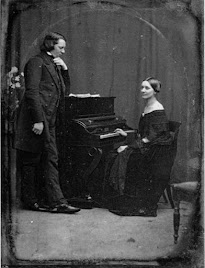Schumann wrote the quintet in a few weeks during the summer of 1842. He dedicated the work to his wife Clara and she was to play the piano part in a private performance of the work in December of 1842. Illness prevented her participation, but Felix Mendelssohn took her place and in a feat of pure musicianship sight-read the piano part. Mendelssohn had some helpful suggestions for the piece after the performance, and Schumann revised the work accordingly.
The Piano Quintet is one of Schumann's greatest works and was very influential in changing the way composers wrote for the combination of string quartet and piano. The work has music of chamber music intimacy along with music that is more symphonic. The quintet is in 4 movements:
 |
| Clara Schumann |
I. Allegro brillante - All five instruments present the driving, robust first theme. The second theme is played by piano alone, and then taken up by the violin and cello. The exposition is repeated. The development section begins with section of transition for piano and cello. The first theme dominates the development section and the reappearance of it in its original form signals the start of the recapitulation. After the second theme the movement draws to a spirited close with parts of the first theme.
II. In modo d'una marcia. Un poco largamente - Perhaps the most well known movement of the quintet is this funeral march in C minor. It begins with 2 bars of introduction from the solo piano, after which the first violin plays the lugubrious melody. The second violin takes up the next part of the theme, with the first violin resuming the melody until the viola takes it up. The second part of the march is repeated and ends quietly. A section of contrast begins in C major with the new theme played as a duet between cello and violin. As with the funeral march, this lyrical theme's second part is repeated. The funeral march is played through again, and after a short transition another section interrupts the march with highly agitated music in F minor that has the piano playing in staccato triplet eighth notes with biting notes in the strings. The second part of this section is also repeated. The funeral march theme returns in the viola with an increased agitation in the accompaniment. The lyrical theme returns, this time in F major. Once more the funeral march plays out, and the movement ends with the piano silent as the strings play a C major chord in harmonics.
III. Scherzo: Molto vivace - Scampering scales cavort in the scherzo until the first of two trios is reached. The trio is a duet in canon for violin and viola. The scherzo takes flight until the second trio is reached. This trio is full of nervous energy as the instruments play four-note motives throughout. The scherzo returns for one more repeat and a coda brings the scherzo to an end.
IV. Allegro ma non troppo - Schumann begins the finale in the key of G minor and gradually makes his way back to the home key of E-flat major. But Schumann goes even further afield with the second subject as it is in the key of E major. Towards the end of this movement Schumann brings unity to the work by a stroke of contrapuntal prestidigitation as he brings back the first theme of the first movement as the subject of a fugue that uses the first theme of the last movement as a counter subject, in essence a double fugue. All of this complexity gives the five instruments a very large, almost orchestral sound. The work ends in a brilliant fortissimo E-flat major chord.





























